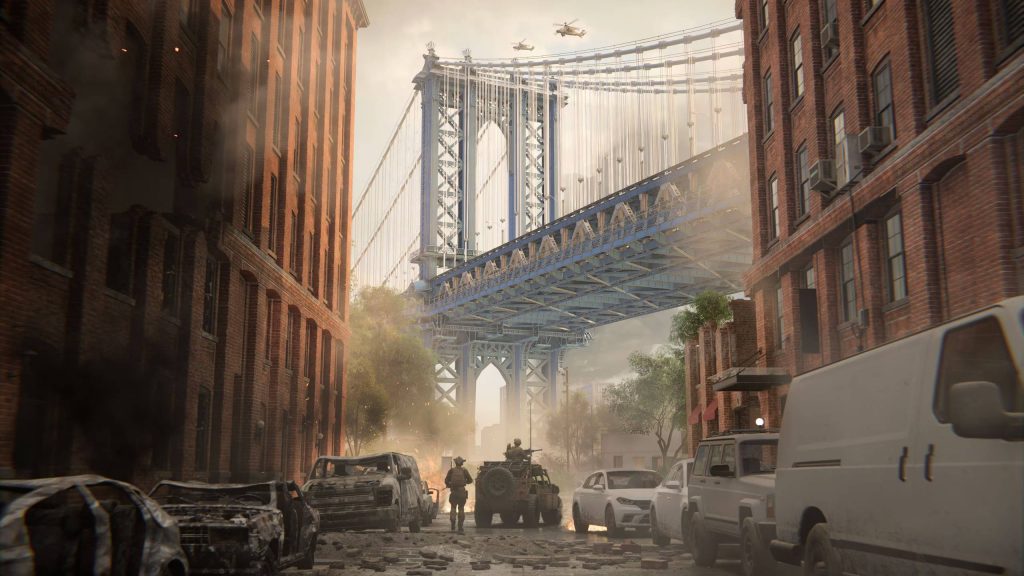If you haven’t heard, the Battlefield series has been through a rocky period. The last title, Battlefield 2042, was a critical dud and fan sentiment grew amazingly bleak. Seeing this, EA went all-in for the newest entry. Battlefield 6 allegedly has a budget of around $400 million, making it one of the most expensive games ever developed (and a case for potential mismanagement with a dash of potential development hell). However, the final result is a vastly improved experience across the board.
The bread and butter of the genre has always been the chaotic, objective-based multiplayer offering. All the classic Battlefield ingredients are here in their (more or less) classic form: destructive environments, tense engagements, maps that encourage strategic teamwork and so on. With multiple maps and eight modes, there’s quite a lot to get acquainted with in Battlefield 6.
Conquest, Breakthrough, Domination, and King of the Hill all return in grand fashion. Conquest and Breakthrough take place within huge maps filled with tanks, helicopters, you name it, and typically require 20 to 40 minutes. With teams of 32 players each, it’s easy to run into opponents often, even on these large, spread-out maps. Squad and Team Deathmatch take place in much smaller maps for 16 players, perfect for those looking for quicker matches without vehicles or objectives other than driving up kill count.
Escalation, a new mode, takes the large-scale mayhem of Conquest and injects a bit of battle royale into it. Two teams of 32 are still fighting over capture points, but this time it’s seven instead of five. The royale element comes into play as capture points disappear and the play area shrinks. I like the finality of successfully capturing a point to 100%. In Conquest, you still have to defend a point you captured, leaving me with an unrequited feeling like the job isn’t done. But here, capturing a zone adds a score to your team and removes it from play, forcing everyone to move to other contested zones or die out of bounds. I actually find myself preferring this new Escalation mode to returning ones like Conquest and Breakthrough, so kudos to the team for improving an already great formula.
“Not only is each Class almost just about equally useful to play as, but they’re not narrowly limited in customization either.”
Rush is a bit more unique. Instead of capturing points, you must destroy them – the franchise’s penchant for environmental destruction manifested into an actual objective. However, two teams of 12 each make portions of these large maps feel unused and overly bare, defeating their purpose. The pacing in Rush is sometimes unnecessarily slow because there are just not a lot of opponents on the field.
Now, this pace and team/map size discrepancy has been somewhat addressed and tuned to a degree. For example, spawn points have been adjusted a bit closer to the other team to ensure long travel times to the objective aren’t a thing. Most of the action is happening around these objective points anyway, so there’s not a lot of wandering around, but the overall sentiment is that it would be better with more players, like the best iterations of the mode.
All this talk of modes, and we haven’t even covered the core gameplay. However, before jumping into matches, the first thing to do is engage in some training and preparation with the four Classes.
Even with mixed opinions on balance, making each Class feel useful is something Battlefield has typically excelled at, and Battlefield 6 is no different. Make no mistake – the distinct functions and equipment each Class brings to the table is one of the coolest things about this entry.
Assault units excel up close, equipping an extra Primary weapon, expanding on their options significantly, whether it’s rushing with a shotgun or dealing with more ranged threats. Support keeps squads supplied and revived like any classic medic. Engineers handle vehicles and heavy weapons, gaining access to launchers and repair torches, while Recon provides long-range sniping and spotting.
Each feels purposeful and satisfying to use, with enough options to tailor one’s loadout. Not only is each Class almost just about equally useful to play as, but they’re not narrowly limited in customization either.
If that wasn’t enough, they each offer two training paths, which have their own passive functions and active abilities. The system feels well-balanced—every match contributes meaningfully to your overall advancement, and there’s a satisfying sense of momentum as you play, the power of the Class scaling as you immerse deeper into the role. Also, say what you will about Open vs Closed Weapons, the former is fun for messing around with different kinds of loadouts. Meanwhile, the latter offers a more traditional Battlefield experience, where embodying your Class and mastering its nuances is the top priority. Having both available is nice, though time will tell how balance concerns in one could impact the other.
Unfortunately, the process of customizing loadouts can feel cumbersome due to the UI. You can’t toggle between individual gun components in the customisation menu, increasing the number of button presses just to see new upgrades. It’s frustrating having to inspect weapon components one at a time with no instant toggle. The lack of any indicators for new attachments is also frustrating, especially after unlocking new options. There’s that glitchy blur animation upon bringing up a weapon—it’s disorienting and annoying.
When I’m browsing weapons in the loadout menu, I want crystal-clear visuals at a glance, not some disorienting cutesy animation that blurs what I’m trying to examine. The weapon background in the Loadout menus is also pretty terrible. They often feature glitched-out lighting that disorients the view of the weapon details. And that animated flicker that happens when loading a weapon each time is downright nauseating.
I do like that you can be taken directly to the shooting range to test any of your unlocked weapons. However, it inexplicably leaves out gadgets, missile launchers, and grenades for players to test. I didn’t have access to the Portal, so I couldn’t practice maps in a no-stress atmosphere. Since many of the maps are gigantic and pretty intimidating, I’d have loved to have a free training mode with no opponents, just to get a lay of the land.
All that aside, Battlefield 6 features some genuinely fun multiplayer maps that accommodate a wide range of play styles. You have the tight, close-quarters skirmishes, the massive scale that accommodates vehicles, and everything in between. While the variety between individual maps is strong, the overall selection of “theaters of war” can feel limited. The five main environments can start to feel repetitive—especially after playing the campaign, which reuses the exact same locations. Still, what’s here is often brilliant.

“The one nag in all this is the minimap. It lacks directionals, forcing you to rely on the compass, which I get is the point, but the latter often blends into the sky and can be hard to read in the thick of combat.”
Liberation Peak stands out as a showcase for the game’s vehicular combat. It’s expansive, well-balanced, and perfect for tanks and jets to dominate while infantry battles over well-placed objectives. However, I gravitate more towards close-quarters maps. Saint’s Quarter in Gibraltar is a highlight, with its colorful streets, narrow alleyways, and layered vertical design that mixes rooftop sniping with gritty street-level firefights.
I especially enjoy the skirmishes that erupt in the drained river beneath the contested bridge—it’s chaotic, tense, and full of creative cover spots. Fighting upward through the trench-like riverbed to reach the bridge feels raw and dynamic. There’s a satisfying balance of cover, verticality, unique interiors, and scenic backdrops.
The one nag in all this is the minimap. It lacks directionals, forcing you to rely on the compass, which I get is the point, but the latter often blends into the sky and can be hard to read in the thick of combat. It’s a small but noticeable quality-of-life issue that adds unnecessary friction to navigation.
Vehicles are another mixed element of level design. The selection is impressive and balanced, though the driving physics leave something to be desired. Tanks can dominate when supported by teammates, yet quickly fold under four anti-tank missiles. On the other hand, jeeps are practically useless beyond quick transport, offering minimal protection. Tanks control as you’d expect, and there’s even the option to use Warthog-like directional movement or traditional movement that follows the camera.
Air vehicles, however, are where I really struggled to enjoy the controls. Jets feel sluggish and blocky, with stiff maneuvering that makes tight turns and evasive tactics feel nearly impossible. Turning control assist on helps somewhat since it automates hover, but even then, flying feels more like piloting an airborne tank than the agile, responsive aircraft from classic Battlefield games.
That brings me to the weapons. I really don’t have anything negative to say about weapon feel and control. The variety is also impressive, with 45 guns across eight categories. Just about every weapon type here, although some more melee options would be nice besides the knife and hammer. Automatic rifles have the kind of recoil one would expect, with options to toggle fire rate. The intense kick of a shotgun blast, the spray of an SMG, the recoil from a sniper shot – it all feels appropriately visceral and satisfying. I’m no gun expert, but their sounds also pass my audio authenticity test. The overall result is punchy and realistic without going over the top.

“In terms of graphics, Battlefield 6 is an impressive showcase.”
The general movement also feels very nice. It’s a much more fluid and fast-paced Battlefield experience thanks to several new additions. Not only do you sprint faster, but you can also sprint slide, which is helpful when taking cover. Leaning in cover and on walls also feels great, not interrupting the overall fluidity or combat flow. Mounting weapons with certain underbarrel attachments to ledges and cover is also thankfully still here, making for some light turret action with your gun.
In terms of graphics, Battlefield 6 is an impressive showcase. It’s not the best-looking game I’ve ever seen, but it’s still a really great-looking first-person shooter. The lighting during matches and the campaign is pretty phenomenal, especially in high-contrast areas where beams of light penetrate the darkness. And even if the extent of destruction isn’t a massive step up over previous entries, it still looks good, feeding into the chaos that makes a proper Battlefield match. Performance on PS5 saw the occasional frame drop but remained solid, which is all the more impressive given the sheer mayhem unfolding.
I also have nothing but praise for the sound design. I don’t think I’ve heard directional sound so distinct and clear as in this game. You can clearly hear the direction of footsteps, gunshots, and even differentiate between someone sprinting, walking, or just crouching. The tinnitus effect happens a tad too often, but can be toggled off in settings, so I can’t even knock that.
Progression is pretty typical of live service shooters, but more impressive than most with how linear and fair the rewards are for your efforts. Experience gain scales at a steady pace, though completing individual match challenges helps. After nearly every large-scale battle, I unlocked something tangible—usually a weapon attachment, and occasionally a new firearm altogether. Even support actions, such as repairing vehicles or spotting enemies for teammates, grant worthwhile XP, which makes every role feel valuable and rewarded.

“Starting or loading into a mission takes nearly two minutes of staring at a black screen with no loading indicator. For a major release in 2025, this is simply unacceptable.”
However, all the weapon skins and charms have a very high weapon mastery requirement. Your first doesn’t unlock until you reach Mastery Level 10, which can take many hours of consistent play. Otherwise, emblems, stickers and so on, unlock at a pretty fair clip.
Last but not least, we arrive at the campaign, easily the most substantial single-player experience the series has seen since Battlefield 4. It’s full-length and cinematic, consisting of nine missions and four difficulty options.
However, there are some notable issues, starting with the absurd load times. Starting or loading into a mission takes nearly two minutes of staring at a black screen with no loading indicator. For a major release in 2025, this is simply unacceptable. Once you’re finally in, the campaign does benefit from solid mid-mission checkpoints that often put you close to where you died.
Structurally, the missions are quite linear. Forking pathways and open-ended combat zones are rare, replaced instead by scripted corridors with the occasional medium-sized skirmish. Everything from the pacing and story beats to the level design feels predictable. Even for players who don’t typically play many first-person shooter campaigns, it’s clear that there’s little new here. It’s still a well-crafted experience with good mission variety and a respectable amount of content.
The campaign’s character rotation also helps keep things engaging. Each mission features a different specialist—one moment you’re a vehicle expert blowing up enemy convoys, the next you’re a stealthy sniper or an assault trooper in close-quarters combat. This consistent change of pace keeps the gameplay fresh, even when the narrative struggles to maintain momentum.

“There’s still work to be done, as is always the case with a multiplayer shooter, and the jury is still out on Portal and battle royale.”
Story-wise, Battlefield 6 doesn’t do itself many favors. The plot begins in the most predictable way imaginable, followed by a clichéd, Hollywood-style conclusion to the first mission. The tone is overly self-serious despite its reliance on endless cinematic explosions. I also didn’t like how the campaign relies on flashbacks as a major plot device due to a lack of proper context or emotional grounding. The frequent jumps between past and present fail to build meaningful connections with the characters or the overarching plot, leaving players detached from any stakes. That said, several missions stand out from a gameplay perspective and, without delving into spoilers, elicit more than a few smiles.
Despite its flaws, Battlefield 6’s campaign offers a decent amount of content, some strong mission design, and enough variety to make it worth playing. Even with all these flaws, Battlefield 6 feels like one of the most complete entries the series has seen in years. Its campaign, warts and all, feels substantial. The class system is smartly balanced, bringing something new to the table while sticking to everything fans love. The progression feels mostly rewarding without being exploitative. The maps are a visual and tactical showcase, even if some modes and vehicle handling quirks reveal rough edges.
There’s still work to be done, as is always the case with a multiplayer shooter, and the jury is still out on Portal and battle royale. However, I can easily see myself coming back, if only for the immersive atmosphere and sheer chaos on a grand scale that only Battlefield can provide.
This game was reviewed on the PlayStation 5.




Great to see a positive review for Battlefield 6! It’s exciting when a beloved franchise makes a comeback. Looking forward to seeing how it evolves!
I completely agree! It’s refreshing to see Battlefield 6 bringing back the classic elements that fans love while also introducing innovative gameplay mechanics. The emphasis on teamwork and strategy really sets it apart from other shooters.